Tai Chi significantly enhances balance and mental clarity, making it a valuable practice for overall well-being. Its slow, controlled movements improve stability and reduce fall risk, particularly in older adults. Additionally, Tai Chi fosters mindfulness, which enhances focus and reduces stress. Different styles, such as Yang and Chen, offer unique benefits that cater to various practitioners.
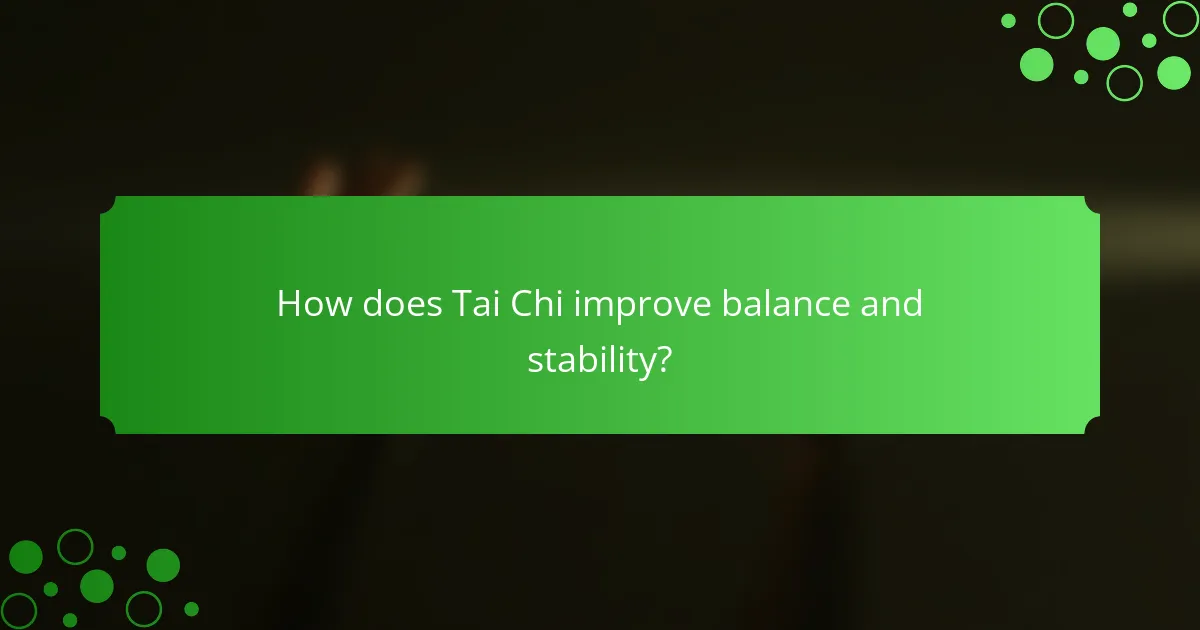
How does Tai Chi improve balance and stability?
Tai Chi significantly enhances balance and stability through its slow, controlled movements. These movements engage core muscles, improve proprioception, and promote better body awareness. Research indicates that regular practice can reduce falls in older adults by up to 47%. Additionally, Tai Chi fosters mental clarity by integrating mindfulness, which enhances focus and reduces stress. This combination of physical and mental benefits contributes to overall stability and well-being.
What specific movements enhance physical coordination?
Tai Chi enhances physical coordination through slow, deliberate movements that promote balance and concentration. Key movements include the “Grasp the Bird’s Tail,” which improves body awareness and stability, and “Wave Hands Like Clouds,” which enhances lateral movement coordination. These exercises foster mental clarity by requiring focus and mindfulness, integrating body and mind. Regular practice can lead to improved overall coordination and reduced risk of falls, especially in older adults.
Which age groups benefit most from balance training in Tai Chi?
Older adults and those with balance issues benefit most from Tai Chi balance training. Research indicates that individuals aged 60 and above experience significant improvements in stability and coordination. Additionally, middle-aged adults can enhance their balance and prevent falls through regular practice. Younger adults may also gain mental clarity and focus, but the most pronounced benefits are observed in older populations. Tai Chi’s slow, deliberate movements promote body awareness and improve proprioception, essential for maintaining balance.

Why is mental clarity a key benefit of practicing Tai Chi?
Mental clarity is a key benefit of practicing Tai Chi because it enhances focus and reduces stress. The meditative movements promote mindfulness, allowing practitioners to clear their minds. Regular practice can lead to improved cognitive function and emotional stability. Research shows that Tai Chi can decrease anxiety levels and increase overall mental well-being. This combination of physical movement and mental engagement fosters a deeper connection between body and mind, enhancing clarity.
How does Tai Chi influence cognitive function and memory?
Tai Chi enhances cognitive function and memory through improved mental clarity and stress reduction. Regular practice fosters better focus and concentration. Studies show that Tai Chi can lead to increased gray matter density in the brain, which is crucial for memory and cognitive processing. Additionally, the meditative aspects of Tai Chi promote relaxation, further supporting cognitive health.
What role does mindfulness play in enhancing mental clarity during practice?
Mindfulness significantly enhances mental clarity during Tai Chi practice by promoting focused awareness and reducing distractions. This focused state allows practitioners to engage more deeply with their movements, improving coordination and balance. Research indicates that mindfulness practices can lead to better cognitive function and emotional regulation, which are essential for maintaining mental clarity. Regular Tai Chi practice, combined with mindfulness, fosters a unique attribute of heightened awareness that can be beneficial in daily life. As a result, individuals often experience improved overall well-being and mental performance.
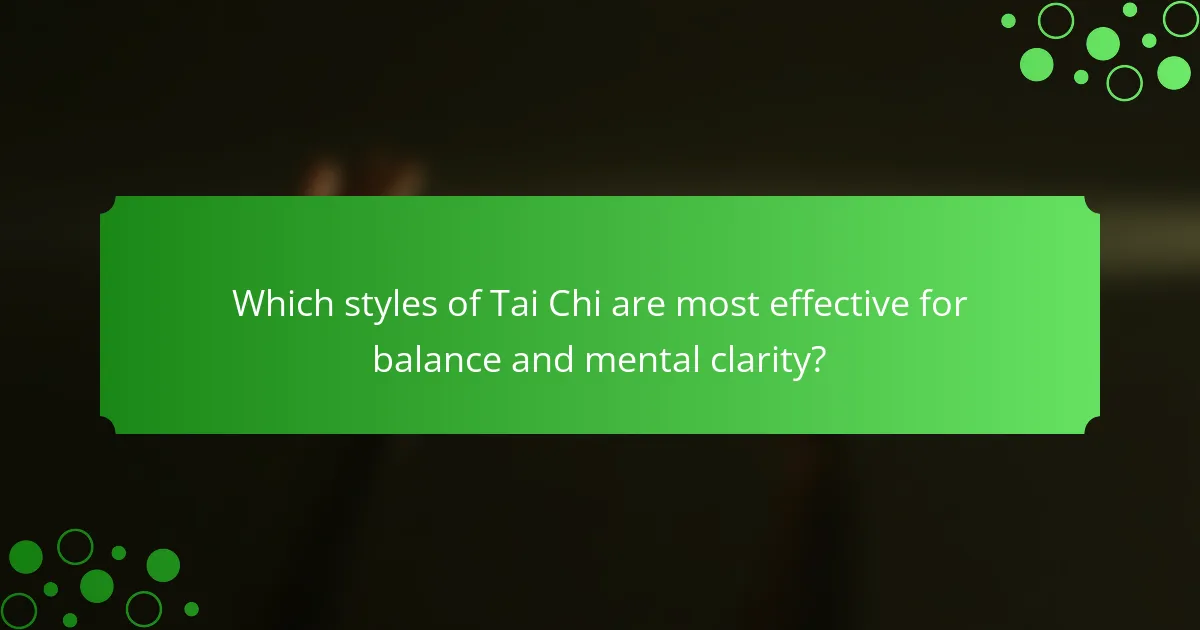
Which styles of Tai Chi are most effective for balance and mental clarity?
Tai Chi styles such as Yang, Chen, and Wu are most effective for enhancing balance and mental clarity. Yang style focuses on slow, flowing movements that improve coordination. Chen style incorporates explosive movements, promoting agility and focus. Wu style emphasizes a lower stance, enhancing stability and grounding. Each style offers unique benefits, making them suitable for different practitioners. Regular practice can lead to improved physical balance and mental calmness, fostering overall well-being.
How do Chen and Yang styles differ in their approach to balance?
Chen and Yang styles differ significantly in their approach to balance. Chen style emphasizes explosive movements and rooted stances, enhancing immediate stability. Yang style focuses on slow, flowing motions that promote gradual balance improvement and mental clarity. Both styles contribute to balance but through distinct techniques. Chen’s dynamic approach builds strength, while Yang’s fluidity fosters relaxation and mindfulness.
What unique benefits do different Tai Chi forms offer for mental focus?
Different Tai Chi forms enhance mental focus through unique benefits, such as improved concentration and stress reduction. The Yang style promotes relaxation and mindfulness, while the Chen style emphasizes explosive power, fostering mental alertness. The Wu style encourages fluidity, enhancing cognitive flexibility. Each form offers distinct pathways to mental clarity, contributing to overall well-being.
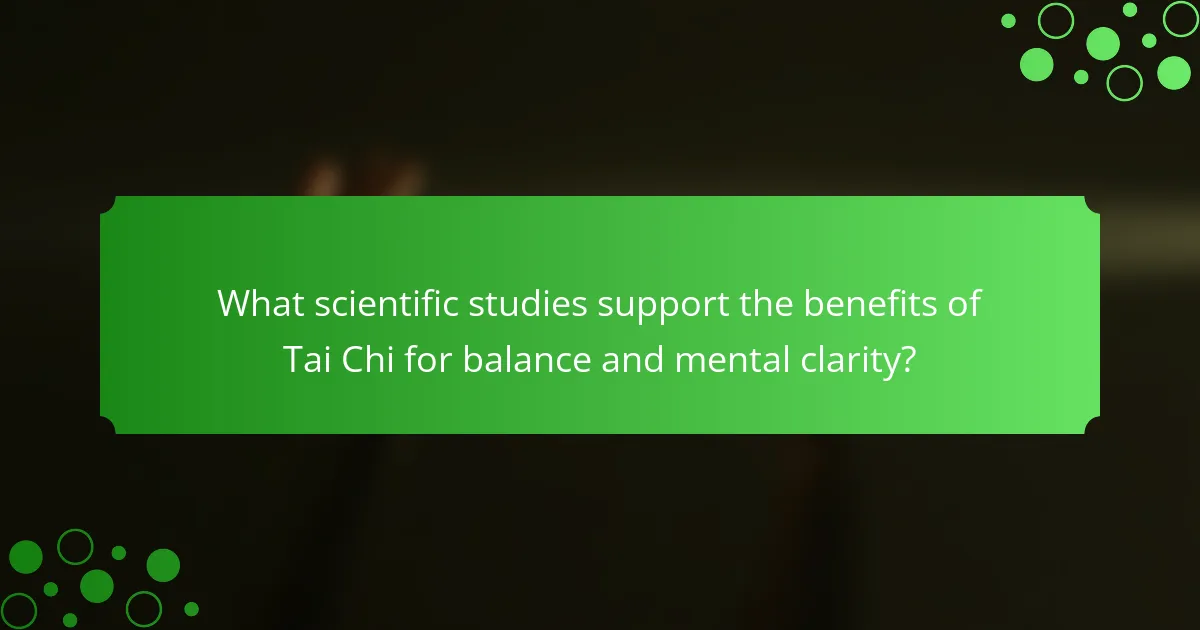
What scientific studies support the benefits of Tai Chi for balance and mental clarity?
Scientific studies confirm that Tai Chi enhances balance and mental clarity. Research indicates that regular practice improves postural stability and cognitive function. A systematic review published in the Journal of Geriatric Physical Therapy found significant improvements in balance among older adults who practiced Tai Chi. Another study in the Journal of Alternative and Complementary Medicine demonstrated enhanced cognitive performance linked to Tai Chi practice, particularly in attention and working memory. These findings highlight Tai Chi as an effective intervention for fostering both physical and mental well-being.
Which populations have shown measurable improvements in balance through Tai Chi?
Older adults, individuals with Parkinson’s disease, and those recovering from strokes have shown measurable improvements in balance through Tai Chi. Research indicates that Tai Chi enhances stability, reduces fall risk, and promotes better coordination. A study involving older adults revealed a 30% reduction in fall incidence after regular Tai Chi practice. Additionally, participants with Parkinson’s experienced improved postural control and mobility. These findings highlight Tai Chi’s effectiveness across diverse populations, making it a valuable exercise for enhancing balance and mental clarity.
How do Tai Chi practitioners report changes in mental clarity over time?
Tai Chi practitioners often report significant improvements in mental clarity over time. Many experience reduced stress and enhanced focus, leading to sharper cognitive function. Regular practice fosters mindfulness, which contributes to clearer thinking and better decision-making. Studies indicate that consistent engagement in Tai Chi can lead to lasting cognitive benefits, particularly in older adults.
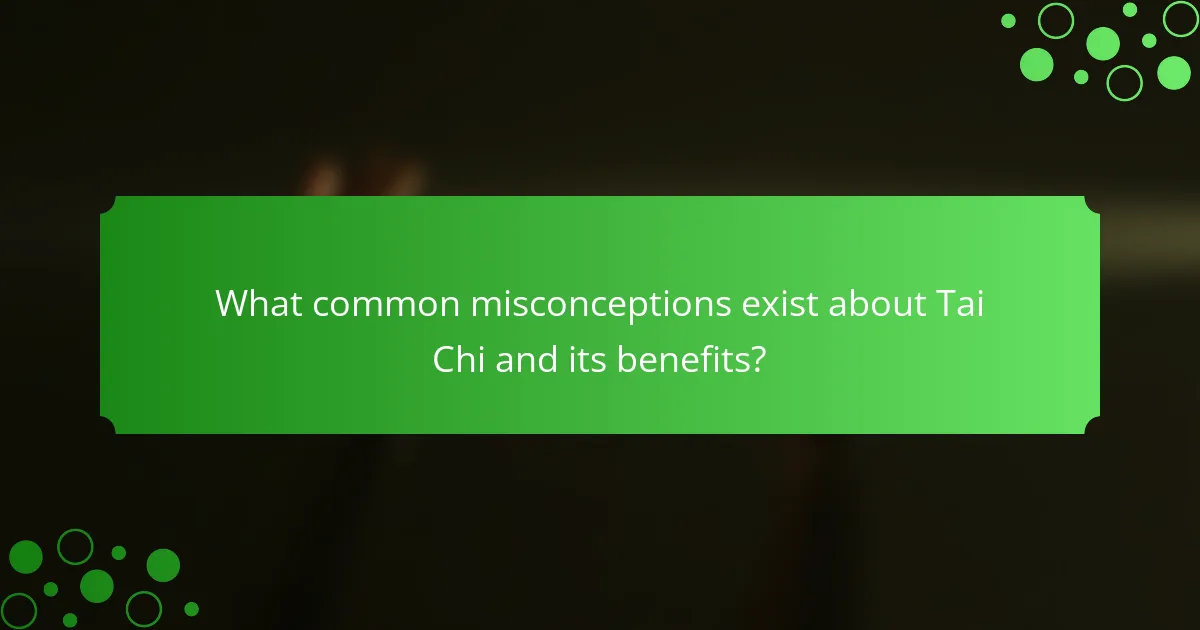
What common misconceptions exist about Tai Chi and its benefits?
Many misconceptions about Tai Chi suggest it lacks real physical benefits. In reality, Tai Chi significantly enhances balance and mental clarity. Research indicates that regular practice improves stability, reducing fall risk in older adults. Additionally, Tai Chi promotes mindfulness, leading to better focus and reduced anxiety. Some believe it is too slow to be effective, but studies show it can enhance cardiovascular health and flexibility. Overall, these misconceptions underestimate Tai Chi’s holistic benefits for both body and mind.
How does Tai Chi compare to other forms of exercise for balance improvement?
Tai Chi significantly enhances balance compared to other exercises. Its slow, controlled movements improve stability and coordination. Research shows Tai Chi reduces fall risk in older adults by up to 47%. Unlike high-impact exercises, Tai Chi minimizes injury risks while promoting mental clarity through focused practice. It uniquely integrates mindfulness, enhancing cognitive function alongside physical benefits.
What are the challenges faced by beginners in experiencing these benefits?
Beginners often face several challenges in experiencing the benefits of Tai Chi for balance and mental clarity. Limited understanding of movements can hinder proper execution, leading to frustration. Physical stiffness or lack of flexibility may restrict their ability to perform poses effectively. Additionally, beginners might struggle with maintaining focus, which is essential for both balance and mental clarity. The social aspect of group classes can also be intimidating, impacting their confidence. Lastly, inconsistent practice can prevent them from fully realizing the benefits over time.
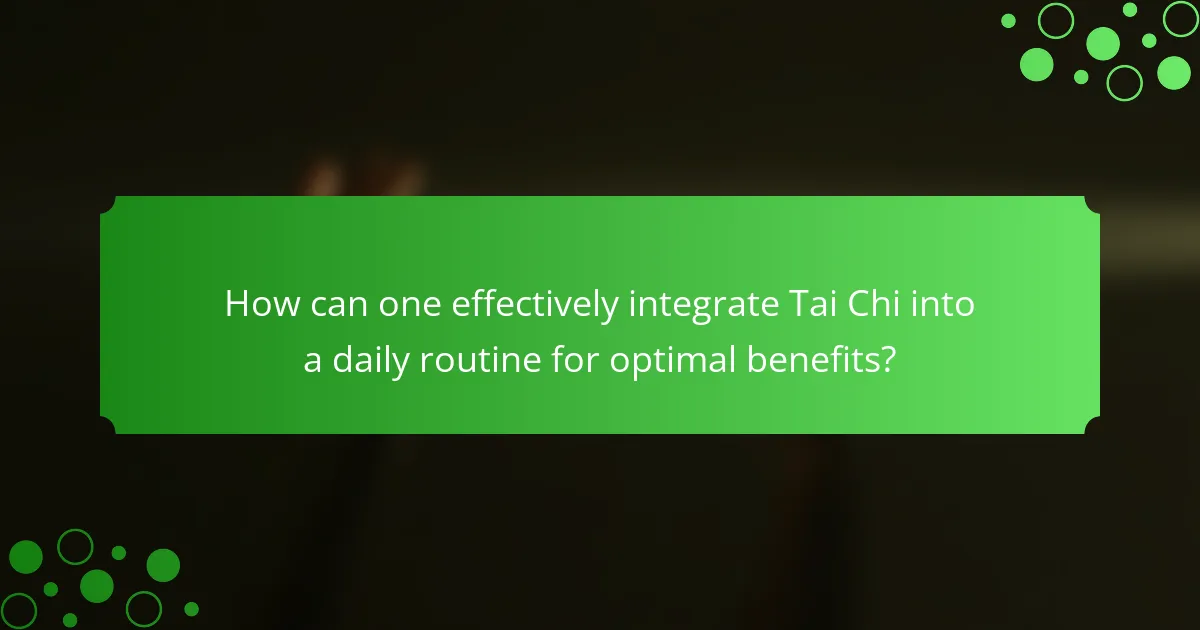
How can one effectively integrate Tai Chi into a daily routine for optimal benefits?
To effectively integrate Tai Chi into a daily routine for optimal benefits, practice regularly and focus on mindfulness. Start with short sessions, gradually increasing duration. Aim for at least 20 minutes daily to enhance balance and mental clarity. Incorporate Tai Chi into morning or evening routines for consistency. Join a class or follow online tutorials for guidance and motivation.
What are the best practices for beginners to start practicing Tai Chi?
To start practicing Tai Chi effectively, beginners should focus on foundational techniques, consistency, and mindfulness. Establish a routine by practicing regularly, ideally several times a week. Begin with basic stances and movements to build balance and coordination, which are core benefits of Tai Chi. Incorporate breathing exercises to enhance mental clarity and promote relaxation. Consider joining a class or following online tutorials to ensure proper form and technique. Lastly, be patient and allow time to develop skills, as progress in Tai Chi is gradual and rewarding.
Which resources and communities can support ongoing Tai Chi practice?
Local Tai Chi classes, online platforms, and community groups can support ongoing practice. Resources like instructional videos and workshops enhance skills. Engaging with local Tai Chi associations fosters connection and motivation. Online forums provide a space for sharing experiences and tips.
What common mistakes should practitioners avoid to maximize benefits?
Practitioners should avoid rushing through movements and neglecting breath control to maximize Tai Chi benefits for balance and mental clarity. Focusing on slow, deliberate motions enhances stability and mindfulness. Additionally, overlooking proper posture can lead to ineffective practice. Regularly engaging in Tai Chi with awareness ensures optimal benefits.